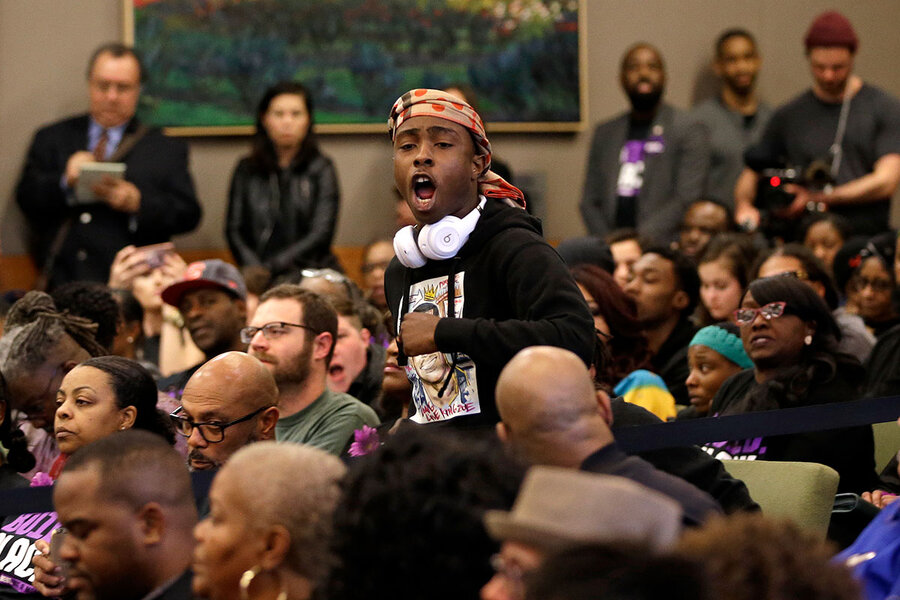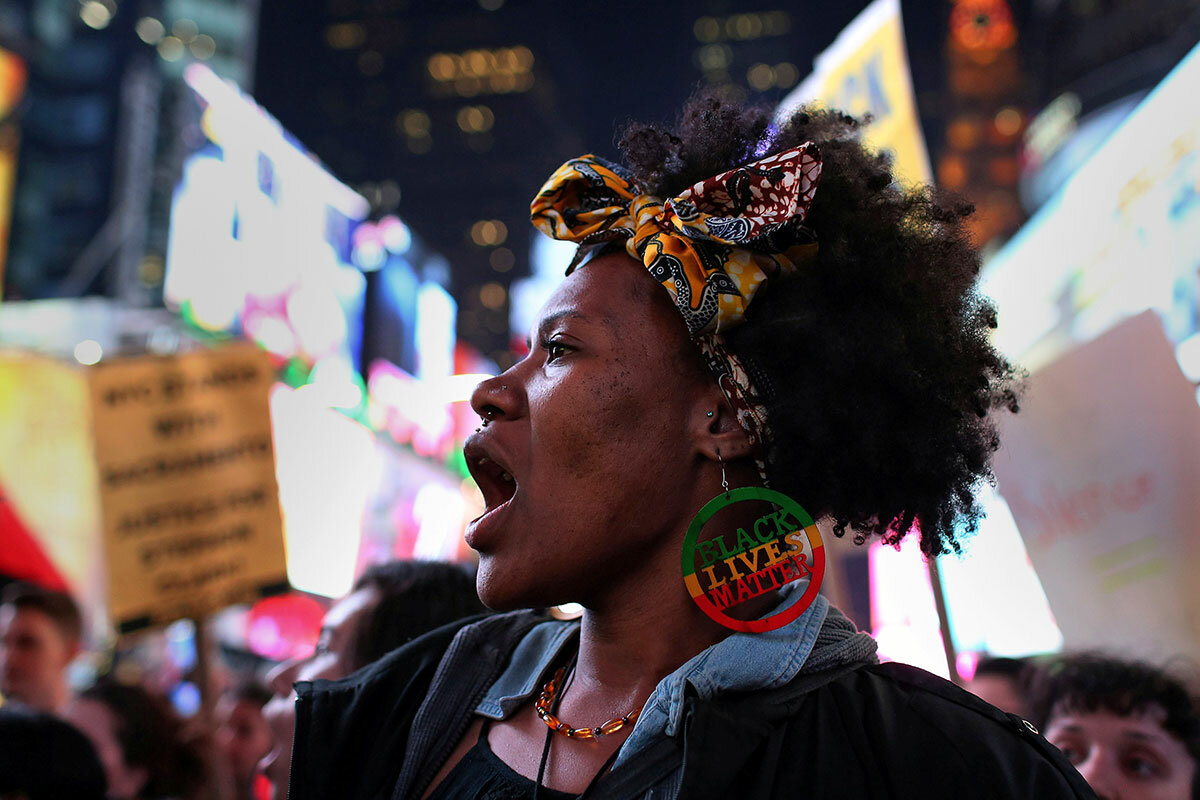At Stephon Clark funeral, a familiar story amplifies drumbeat for change
Loading...
| Los Angeles
It’s a news story that’s grown uncomfortably familiar in the past four years: A young black man, apprehended by police, flees a scene. The officers give chase and, thinking he has a weapon, fatally shoot the suspect. No weapon is found. The community rises up in protest, demanding justice.
This time, the community in question is Sacramento and the young black man is Stephon Clark, a father of two who was shot eight times by police on March 18, according to an autopsy released Friday. His funeral the day before drew hundreds of demonstrators to the California capital. The gathering capped more than a week of traffic-stalling rallies. Activists reignited calls to end what they say is systemic racism among law enforcement and to punish officers involved in the deaths of unarmed civilians – too many of whom happen to be black and brown men.
“You’re killing us. It’s genocide, it feels like genocide,” Tanya Faison, head of Black Lives Matter Sacramento, reportedly said Tuesday at a City Council meeting at Sacramento City Hall. “Those officers need to be fired. That’s the only way we’re going to get justice.”
But taking police officers to task – especially for the use of excessive or deadly force – is a tough ask at best. Studies show that law enforcement agents rarely face prosecution for a shooting. And few of those who do end up with a conviction or prison time. Administrative actions are almost as hard to pursue. State, local, and department policies erect a series of barriers that, according to legal scholars, make it difficult to discipline, much less fire, an officer for misconduct that stems from use of force. Changing those policies is further complicated by the fact that the decisions are often tied to collective bargaining agreements.
By themselves, such laws and policies make sense. Cops have a demanding, dangerous job and they need to know that they’re not at risk of losing their livelihood or going to jail every time they do something expected of them, like using force, in the line of duty.
Legal analysts point out, however, that these policies don’t operate in a vacuum. Race and class tensions have coexisted with policing in America since at least the 19th century, a reality that has resulted in deep mistrust between law enforcement and minority communities. Events like Mr. Clark’s death exacerbate the situation. Laws and policies that seem to shield cops from accountability further heighten that mistrust, critics say, especially since police possess the greater share of power and authority in most interactions with civilians.
“Do these laws protect good cops who found themselves in an unfortunate situation? Yes. But they also protect bad actors,” says Kami Chavis, a law professor and director of the criminal justice program at the Wake Forest University School of Law in Winston-Salem, N.C. “We have to balance some of those protections against protections of citizens who are at the mercy of these officers.”
Finding accountability
There are two main ways that law enforcement agents can be held accountable after an incident involving use of force results in a civilian death or injury.
One is legal: A municipal, state, or federal agency, or some combination of the three, can investigate the officer’s actions under a number of statutes that regulate police conduct. Those statutes present a slew of challenges, including vague definitions of what reasonable use of force looks like, and standards that require prosecutors to prove beyond reasonable doubt that an officer used force with the specific intent of violating the victim’s constitutional rights.
Complicating matters is the fact that cops, in the course of their duties, are allowed to do things that otherwise would be considered crimes, says Seth Stoughton, a former police officer and now assistant professor at the University of South Carolina School of Law in Columbia. They can drive around with illegal drugs to take into evidence, violate traffic laws during a pursuit, or use force in interactions with resistant civilians. That makes it difficult to identify whether or not the officer committed an infraction at all, he says.
“An officer may use exactly the same amount of force and have it be legal in one incident and illegal in another,” Professor Stoughton says. “So we have these additional protections to avoid punishing them for doing their job the way we want them to do it.”
In the end, few investigations amount to much. One study, which looked at more than 3,000 criminal cases against cops between April 2009 and December 2010, found that 33 percent were convicted. Of those, only 36 percent ended up in prison. And that’s when allegations against an officer even made it to court. More often – as in the cases of Michael Brown in Ferguson, Eric Garner in New York, Tamir Rice in Cleveland, and, this week, Alton Sterling in Baton Rouge – no charges are filed against the cops involved.
The other method of holding officers accountable is procedural: Administrators have the right, duty, and ability to investigate and sanction officers who violate department policy. But here, too, there’s a high bar for proving inappropriate use of force. In about a dozen states, including California, a Law Enforcement Officers' Bill of Rights codifies that standard and often bars the public from learning whether or not an implicated officer has a history of bad behavior. It also outlines a method of appeal against disciplinary actions.
So even when a cop is fired for misconduct, it doesn’t always stick. A Washington Post investigation found that since 2006, 1,881 officers in the nation’s largest police departments were terminated for actions that betrayed the public trust. Nearly a quarter were reinstated after lawyers were hired to review the process.
Securing rights or providing cover?
Advocates for law enforcement say these protections are well within police officers’ rights. It’s not supposed to be easy for law enforcement officers to lose their jobs because they acted in accordance with training, says James Touchstone, legal counsel for the Sacramento-based California Peace Officers Association. He disputes the notion that having a bill of rights prevents meaningful oversight and accountability.
“Is there always room for improvement? Yes. California law enforcement is always striving to improve daily,” Mr. Touchstone says. But he adds that police officers, like everyone else, “are entitled to appropriately defend themselves when they face allegations of wrongdoing. An accusation doesn’t make it true.”
Critics argue, however, that these policies need to be reexamined in a way that accounts for the dynamics of race and class, and by extension, power, that exist in interactions between law enforcement and the communities they serve. Legal mechanisms that shield officers from liability, while justifiable on their own, shift a significant burden of risk and uncertainty to the communities most often surveilled by police – which happen to be disproportionately high-crime, high-poverty, and majority-minority, Stoughton says.
“There’s a real imbalance there,” Wake Forest’s Professor Chavis adds.
These laws thus reinforce mistrust already inherent in the police-community relationship. Among cops, having so many barriers to liability bolsters what military veteran and senior National Review writer David French calls a “sense of risk way out of proportion to the actual threat.”
“It’s often said that cops have mere seconds to make life-and-death decisions, and that’s exactly right,” Mr. French writes. “But do you know who else has mere seconds? The suspect. A suspect who is far more likely to be frightened, confused, disturbed, or drunk than he is to be committed to killing cops.”
To minority, and especially black, communities, the laws embody a system that treats their lives as expendable – or at least less valuable. “Every male person of color cannot be a suspect. You can’t shoot on sight. And unfortunately ... we’re developing a rule that it’s OK to shoot certain people on sight,” Chavis says. “These laws provide cover [for that].”
Yet experts also contend that addressing the issue requires something other than stripping law enforcement of protections, or increasing the number of criminal prosecutions against officers. Going after a single officer in a particular case – whether it’s Michael Brown or Stephon Clark – could speak to a community’s broader sense of justice, they say. But it doesn’t deal with the daily interactions between police and the public that create hostility. It doesn’t force police, political leaders, or the public to consider hard questions about what law enforcement’s mission is and how they should go about accomplishing it. And it doesn’t, they add, challenge the structures that allow for all this to take place.
“People respond to the culture and systems they’re operating in,” says Judy Lubin, head of the Washington-based Center for Urban and Racial Equity and co-founder of Sociologists for Justice. “The legal structure needs to be challenged ... with transparency and accountability and openness to the public in mind.”









